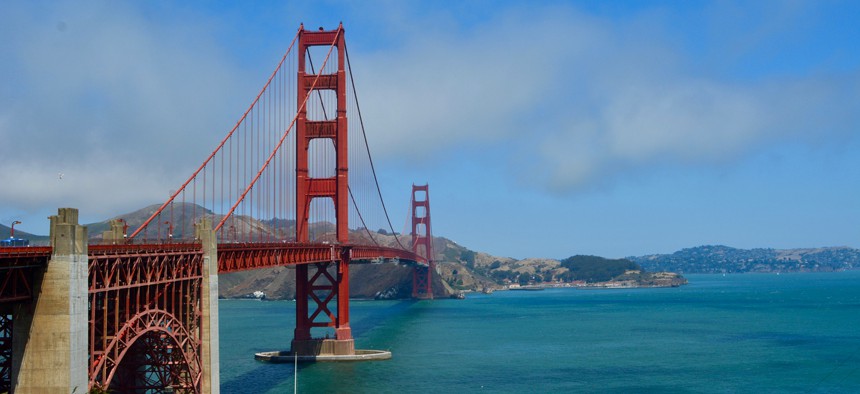Across a frightened nation divided by politics and culture, a fragile harmony is ascendant, as Americans in small towns and large cities alike cry out in trembling unison: Hey, where did all these Californians come from?
Talk of a “California Exodus” is sweeping the country—and so are anxieties about its effects on the rest of the West. In October, the Boise mayoral candidate Wayne Richey proposed at an election forum to build a $26 billion wall to keep out people moving from the Golden State. (His backup plan to stop the invasion of Boise? "Trash the place.”) A viral Wall Street Journal article recounted the plight of a small Idaho town buckling under the stress of thousands of inbound Californians. And this month, Texas Governor Bill Abbott issued a warning on Twitter to Californians moving to his state: “Remember those high taxes, burdensome regulations, & socialistic agenda advanced in CA? We don't believe in that.” The sentiment was echoed in various warnings in Dallas newspapers about the awful “California-ing” of North Texas.
In 2016, President Donald Trump swept the Republican primary with a simple message: Build a wall to keep out the immigrants. Today, a new anti-migration theme is sweeping the country: Build a wall to keep out the Californians.
But is the California Exodus real?
From one perspective, the answer is very clearly yes. In 2012, California gained 113,000 people on net through domestic and international migration. Last year, California lost more than 130,000 people on net to migration, according to its own demographers. The state still grew, thanks to births, but at the lowest rate on record. Now the U.S. state most synonymous with all varieties of growth—vegetal, technological, and human—is at the precipice of its first-ever population decline.
When you pull back the lens a few decades, however, the “exodus” doesn’t look quite so biblical. The number of outbound Californians in 2018 was no higher than it was in the mid-2000s—or the mid-1990s. “After the Cold War ended, there were huge federal cutbacks in the defense and aerospace industry, and the economy dried up in parts of Southern California,” says H. D. Palmer, the deputy director for external affairs at the California Department of Finance. “Exodus is a freighted word, but if anything was an exodus, it was the mid-1990s.”
So if Californians aren’t moving more than in previous years, why are so many places suddenly freaking out about the influx of Golden Staters?
The longtime residents of states chosen by Californians might be more anxious about change than they once were. Texas in particular is in the midst of a transformation from a ruby-red conservative stronghold to a more mixed state with blue metros and red rural areas. In this context, the next SoCal family that U-Hauls into North Texas isn’t just some nice couple with different taste in barbeque; instead, they’re potentially the demographic straw that breaks the GOP’s back.
And while California’s overall out-migration isn’t unprecedented, some states and counties are taking in an unprecedented share of newcomers from there. The number of Californians moving to Idaho, for instance, increased by 120 percent from 2012 to 2018. The number of Los Angeles residents moving to Dallas and Houston declined in those years, but the number of Angelenos moving to Plano, Texas, tripled.
California’s population problem isn’t just about adults who are leaving; it’s also about the kids who aren’t there to begin with. The biggest issue, you could say, isn’t exodus, but genesis.
Last year, I wrote that expensive housing in America’s richest cities was pushing away families with children, leading to a “childless city.” California’s biggest metros are on the bleeding edge of this trend. Since the end of the Great Recession, home prices in Los Angeles, San Diego, and San Francisco have increased by 70 percent, 80 percent, and 116 percent, respectively. This has driven middle-class families to either move inland or leave entirely. San Francisco has the lowest percentage of children under 18 of any major city in the U.S., and Los Angeles County has seen a 17 percent decline in the number of kids in the past 10 years.
Births are falling, due to declining fertility among all groups, including Latinos, who make up about one-third of the state’s population. And deaths are increasing as the population ages. The state's annual natural growth—births minus deaths—has plummeted from more than 300,000 in 2008 to 180,000 today. According to figures shared by the California Department of Finance, the median age is rising 40 percent faster than that of the rest of the U.S. population.
As the state gets older, it’s also getting richer. California’s incoming residents are most likely to be 20- and 30-somethings making more than $100,000 a year with bachelor’s or graduate degrees, while its outgoing residents tend to be less educated and earn less than $50,000. Over time, this trend will make California wealthier in average income—but poorer in electoral power. William Frey, a demographer with the Brookings Institution, has projected that, for the first time ever, the state's population slowdown will likely cost it a congressional district after the 2020 census. (Texas, he said, could gain three seats.)
California’s crisis isn’t that people don’t want to be there. Lots of people want to live near the Pacific coastline, but expensive housing has drawn a velvet rope around that economy for the richer, more educated, and old. The Golden State is slowly turning platinum—an exclusive and opulent shade of gray.






